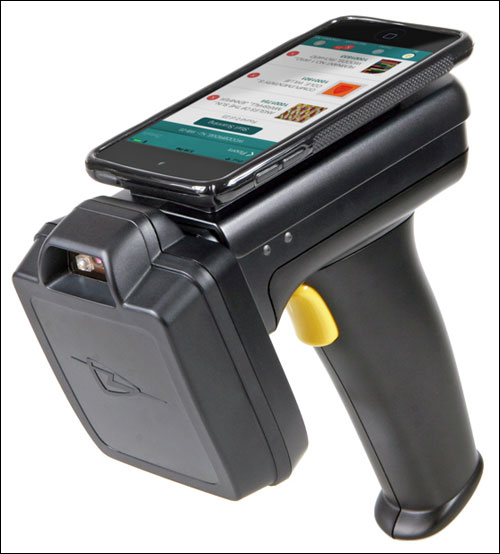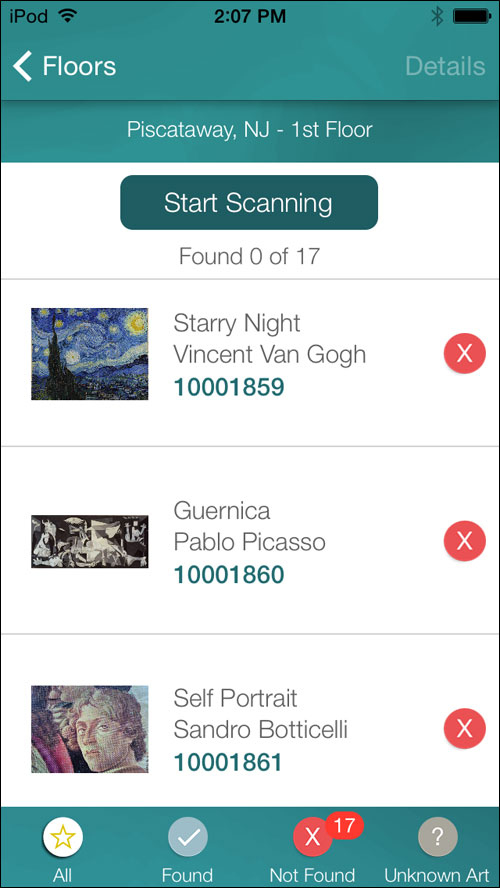Jun 06, 2014NCS Technologies, a business solutions provider based in Piscataway, N.J., has developed an art-management solution that has enabled one international customer to deploy personnel equipped with Apple iPhones and Bluetooth readers to track its works of art that it owns and displays at its various office facilities. The solution consists of a Technology Solutions (UK) Ltd. (TSL) Bluetooth reader that pairs with an iOS device, such as an iPhone or iPod Touch. NCS developed the software and application that runs on the iOS device to manage the collected read data.
In 2013, one of NCS Technologies' customers (an international company that has asked to remain unnamed) approached NCS seeking an art-tracking solution to help manage the approximately 600 pieces of artwork it has on display at offices around the world. Tracking corporate art at multiple locations can often be challenging, the firm told NCS, and if art is moved or removed, finding a single piece of art can become nearly impossible.

At the time that the company met with NCS regarding its art-tracking challenges, it had an immediate need for the system to record the movements of artwork while it consolidated multiple facilities into a single site. The firm already had passive ultrahigh-frequency (UHF) RFID tags and bar-code labels attached to each piece of art, and management employed handheld RFID readers to conduct periodic inventories of the artwork. However, says John Eldridge, NCS Technologies' chief technical architect, that system had some shortcomings. Its software was not intuitive for staff members to use, and was becoming outdated; moreover, the readers did not always operate as required—the handhelds provided only a limited amount of data to the user on its built-in screen.
NCS developed new software for the company and selected TSL's 1128 Bluetooth UHF RFID reader—which transmits data to a smartphone via a Bluetooth connection—since it enables users to collect, manage and view read data on their mobile devices. That, Eldridge says, allows individuals to incorporate some of the phone's functionality into the solution, including taking pictures, enlarging photos onscreen and viewing data in higher resolution. The solution could also draw from the phone's GPS functionality to further create location-based data in the software, explains Mark Smith, NCS Technologies' senior mobile architect.
By September 2013, NCS had provided the system to the company so that it could begin managing the artwork's movements during the consolidation, as well as conducting periodic inventory counts. The reader itself is designed so that the phone can be mounted on it. Before undertaking an inventory check, a user downloads the NCS app onto a mobile phone and pairs the reader with that phone. The user then inputs the specific floor or area of the building into the phone's app, and views a list of the artwork that should be located in that area. The app also displays pictures of each item, which can be expanded via the phone's touchscreen if necessary. Employees can then begin reading the tags at that location, and the app will display that list, while also indicating any items that are missing or are in the wrong location. It can also display the expected location for a particular work of art.
The phone forwards the data to software residing on the company's server, via a Wi-Fi connection, to be stored and managed there by authorized personnel. If the individual with the handheld reader is authorized to do so, he or she can make such changes as attaching a new tag to a piece of art (if the original tag is not operating) and associating it with that item. The employee can also take a picture of the item with the phone, if necessary (if the original picture is unclear, for instance, or if the company needs to document damage to the art).

When the company's managers were testing the technology, Smith recalls, they immediately discovered a piece of art mounted on an employee's office wall that had, in fact, been intended to be located elsewhere.
The software residing on the customer's server enables the art-management group to view where artwork is located at all of its facilities worldwide. This provides the company with an accurate inventory count, and also allows it to make any necessary changes.
According to Eldridge, the solution could now be sold for art management to other clients. Additionally, NCS could provide the software for use either on a customer's server, or as a hosted solution with which customers could simply access data on an NCS server.

